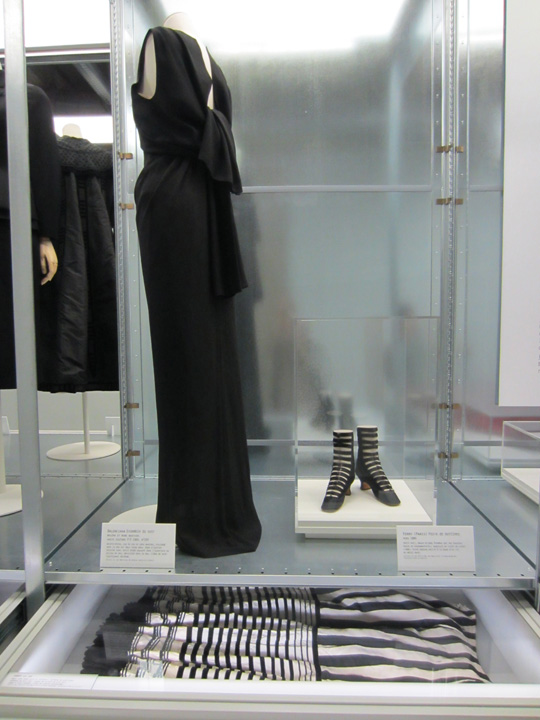Innovative Exhibition Design Strategies for Cristóbal Balenciaga and Comme des Garçons at Musée Galliera
/by Ingrid Mida
Balenciaga Cape du soir, 1963 and Collier c.1895
There couldn’t be a more unlikely exhibition venue than Aux Docks - cité de la Mode et du Design in Paris. At the other end of town from Musée Galliera's permanent home, which is currently under renovation, this temporary venue sits in a gritty industrial part of town overlooking the river Seine. This contemporary space has exposed concrete walls, punctuated by industrial pipes and has been the temporary home for the musée Galliera exhibition of Cristóbal Balenciaga, collectionneur de modes and Comme des Garçons White Drama. Two adjacent long and narrow rooms served as the exhibition space. Bringing fashion into these blank, cold, industrial boxes must have been a curatorial challenge, since there is an apparent lack of temperature and humidity controls as well as absence of hangable wall space. Nevertheless, Olivier Saillard and his team of the Gallieria rose to the challenge with display techniques that are as innovative as they are creative and the result are two tightly curated exhibitions featuring selected works of two notable designers - Cristóbal Balenciaga, collectionneur de modes and Comme des Garçons White Drama.
Balenciaga Installation Shot by Ingrid Mida
In the first room, Cristóbal Balenciaga's personal archive of historical garments, print material and other artifacts is presented beside selected examples of his work. This personal archive was recently donated to the museum and includes a range of items from the nineteenth century such as dresses, collars, corsets, shawls, mantles, capes, as well as fashion plates, books and journals. Set alongside Balenciaga's design work, the reinterpretation of fashion history for design inspiration is made evident. Key to the creation of this link is the innovative display techniques, incorporating modular drawers with clear protective insets, which sit underneath cube-like metal vitrines. The drawers are stacked in fixed position, but open, suggesting links between adjacent pieces. For example, beaded and embroidered black capes and mantalets from the late nineteenth century are shown alongside a Balenciaga cape du soir from 1960, and a 1945 jacquette de soir. The shapes, colours and beading techniques are remarkably similar, and creating links through time and history. Although there is minimal text, none is needed; the objects speak for themselves.
Balenciaga Exhibition, Installation Shot by Ingrid Mida
What I found startling about this exhibition is not the link of inspiration with creative result, but rather the creativity of display. Clothing is not only shown on conventional mannequins, but also presented in clear plexi-topped drawers, as flat storage in clear boxes, or hanging from padded hangers. The flat display in clear boxes offers a contemporary solution for delicate historic garments that might otherwise never be put on display, as well as circumventing the need for custom mannequins. The modular metal units have a slightly mirror like quality that creates a ghost-like reflection of the backs of the garments, as well as creating synchronicity with the industrial setting of the venue.
Comme des Garcons White Drama, Installation Shot by Ingrid Mida
The adjacent room presents Comme des Garçons White Drama an exhibition of thirty white garments by Rei Kawakubo in futuristic white plastic bubbles. Whether these bubbles were designed protect the garments from pollution or for artistic effect, the choice was an inspired one. Within the bubbles, between three to six blank-faced white mannequins wear white garments. Devoid of colour, except for a few pieces with hand-painted graffiti, the focus is on the sculptural elements created by draping, folding, sculpting, and crinoline-like additions to the forms.
Comme des Garçons Installation Shot by Ingrid Mida
Although Rei Kawakubo denies that what she creates is art, these garments are wearable art. With protuberances of crinoline-like skirt structures, webs of crochet, or bags of flowers, these pieces might be wearable, but not for by anyone with a wallflower personality. Donning such a garment would be suggestive of performance art. Adding to this impression of fashion as art are the unique headdresses “worn” by the mannequins. Created out of disparate materials, ranging from what looks like could be white steel wool, pillowcases or spray on Styrofoam, these headdresses act as sculptural elements unto themselves. The overall effect is futuristic and surreal.
Balenciaga Installation Shot by Ingrid Mida
Some have argued that fashion becomes art when it is presented inside the context of a museum. In absence of conventional museum space, the curatorial team of the Galliera has used innovative presentation techniques within an industrial space that redefines exhibition design strategy. A pristine white box is no longer a prerequisite and in fact, it seems that embracing the challenges of unlikely and difficult spaces can offer opportunities for curatorial and exhibition design innovation.
This exhibition ends on October 7, 2012. For more information, visit











